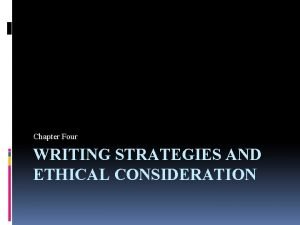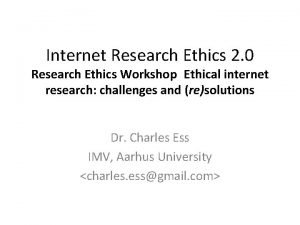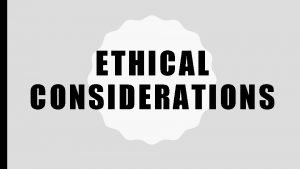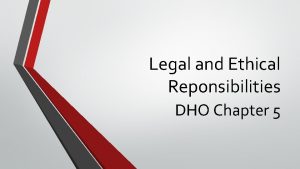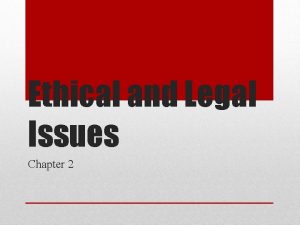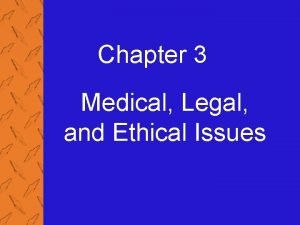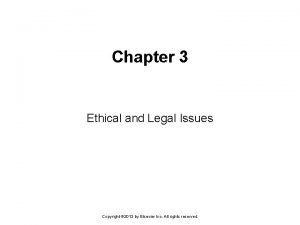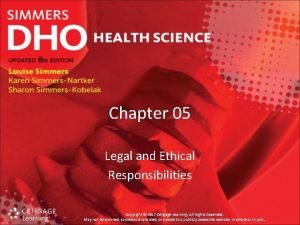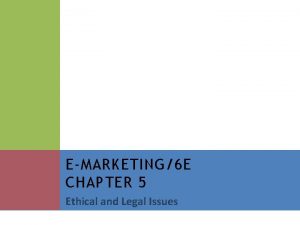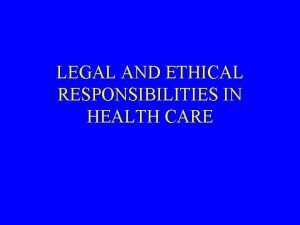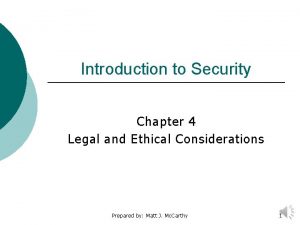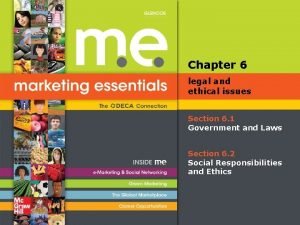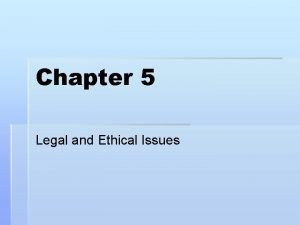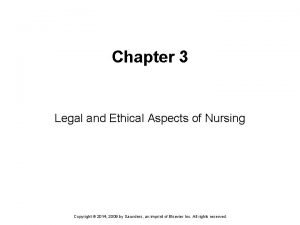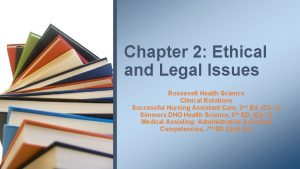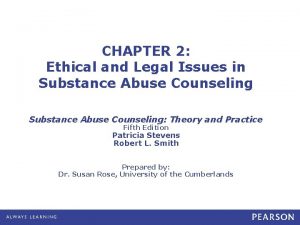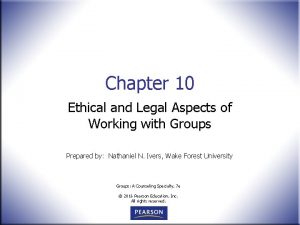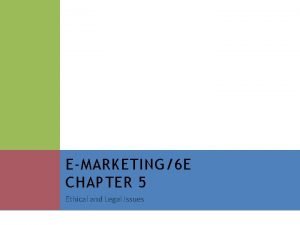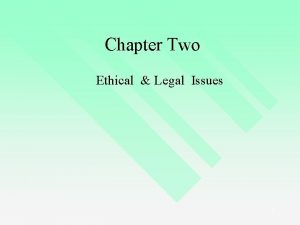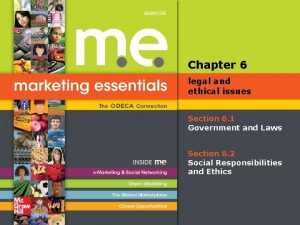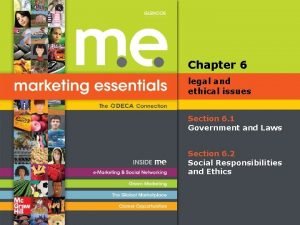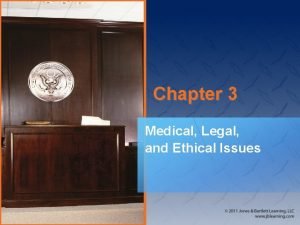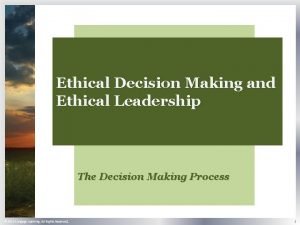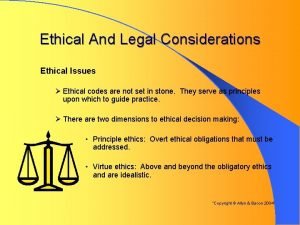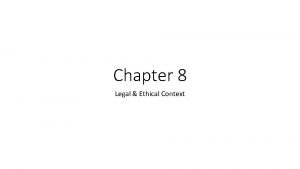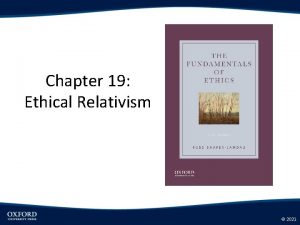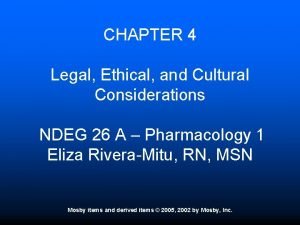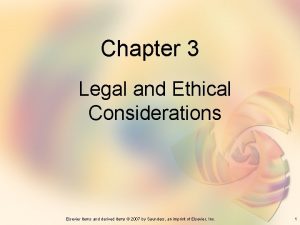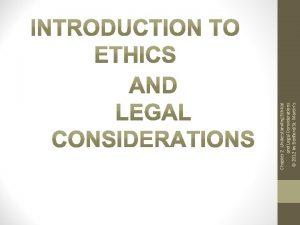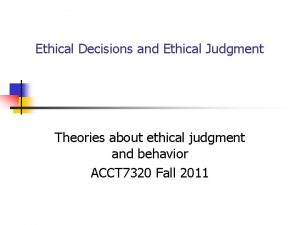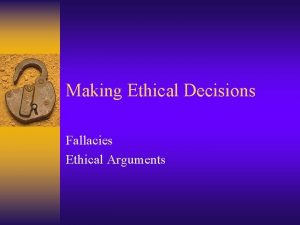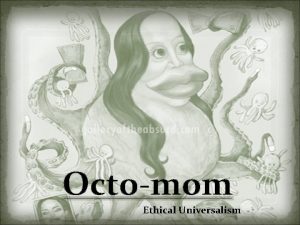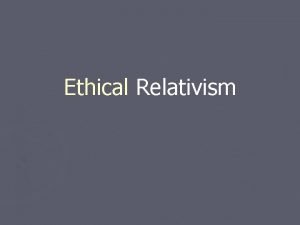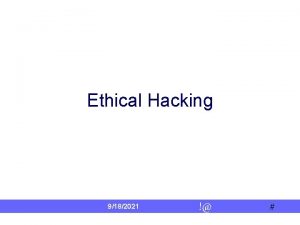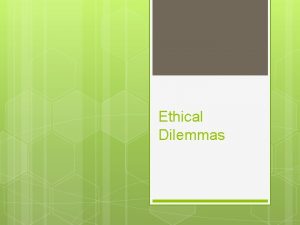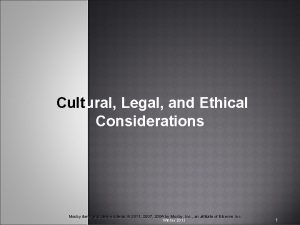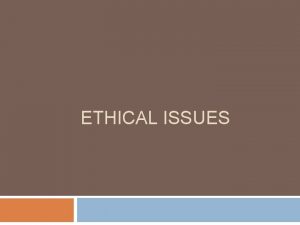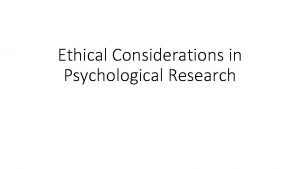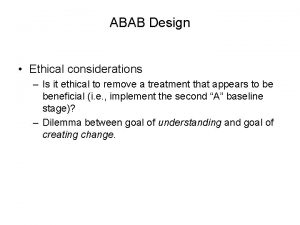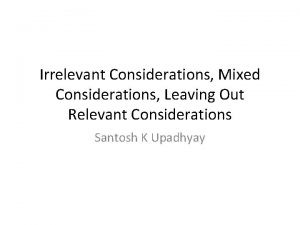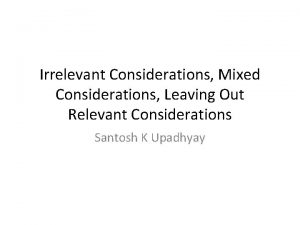Chapter 4 Legal and Ethical Considerations 4 1



























- Slides: 27

Chapter 4 Legal and Ethical Considerations 4. 1 Management Obligations 4. 2 Social and professional responsibilities 4. 3 Ethical considerations 4. 4 Government regulations 4. 5 Protecting ideas 08 -04 -2008 1

4. 1 – Management Obligations (Compulsions) § Government industrial legislation has increased steadily since the start of the industrial revolution § Understand the aims and reasons behind Government regulations, and be able to work with government agencies to satisfy these requirements § Need to maintain a greater awareness of the environmental and social obligations placed on organizations by the community 08 -04 -2008 2

Management Obligations § The requirements and norms (standards) of present and future society § The manager at the same time needs to resolve the conflict which can exist between the needs of society, employees, shareholders, customers and suppliers § It is important that employees are adequately trained and developed 08 -04 -2008 3

4. 2 – Social and Professional Responsibilities Three factors differentiate a professional group from society or club: 1. Whether members who are admitted to it are required to reach a specific academic level 2. Whether technical and ethical standards of performance have been specified for members 3. Whether a body exists to set and enforce these standards, to provide ongoing guidance to members and to administer membership 08 -04 -2008 4

Social and Professional Responsibilities § Most professional bodies have rules of conduct and can expel members if these rules are broken § Members who belong to management professional bodies also often belong to other professional association, such as in engineering, physics, accountancy, marketing and personnel § Two areas of Special Concern: – Environmental protection – Responsibility to employees 08 -04 -2008 5

Social and Professional Responsibilities Environmental protection There are three main environmental considerations: 1. Pollution, usually created as a by-product in the day-to-day operation of the company, must be eliminated • Processes used during manufacture do not create waste by-products which harm the environment • Products themselves do not create an environmental hazard when being used • Environmental considerations must be paramount at every stage in a product’s life cycle 2. The use of natural resources in the manufacture of the product, (particularly those that are non renewable) should be minimized 3. Health and safety issue must be considered, relating to the work environment and to the product 08 -04 -2008 6

Social and Professional Responsibilities Environmental protection Major steps in the introduction of an environmental policy 1. Enhance environmental awareness • • • Management Leadership Employee involvement Employee training 2. Develop environmental strategies • • • Clear communicated aims Develop methods/processes Prioritize tasks 3. Conduct environmental Audits • • • 08 -04 -2008 Set measures Conduct audits/feedback Continuous improvement targets 7

Social and Professional Responsibilities Responsibility to employees § There is no job, which is for life § Employees moving from long term employment relationship with their companies to short term contract § There is no longer any ‘loyalty’, only a contract to work together for mutual good § The relationship is no different from that between competitors who form an alliance for mutual benefit (alliance of non-Muslims against ……) § but companies have an obligation to provide the opportunity for employees to learn and develop § Achievement must be rewarded, not seniority § Employees may also move at their own will for better opportunities 08 -04 -2008 8

4. 3 – Ethical Considerations § an organization is not accountable for the ethical behaviour of its employees ? § Unethical business practices by employees reflect the values, attitudes and beliefs of an organization’s operating culture § the ‘if it is legal – it is ethical’ attitude ? § Organizations should set their own internal values, which lead to laws of conduct, and these should go beyond minimum legal requirements 08 -04 -2008 9

Ethical Considerations § Ensure that customers ‘needs’ are kept in sharp focus § Ethical conduct in advertising is often controlled by legislation and by voluntary standards boards § Customers should be given adequate information during the marketing stage, to ensure that they are capable of making a correct decision when choosing a product which satisfies their needs 08 -04 -2008 10

4. 4 – Government Regulations § which seek to effect the organization’s conduct towards its employees § which protect consumers § environmental protection laws § laws on the company’s trading relationships 08 -04 -2008 11

Government Regulations Employees Regulations § Employee-related regulations cover a wide spectrum – Rules governing the employment of people – Safety and conditions at work – Conditions of employment § The factories Act of 1833: – Conditions of employees – Prohibited the employment of children under nine years of age – Hrs worked per day § for children between 9 and 13 yrs to 9 hrs § for children between 13 and 18 yrs to 12 hrs 08 -04 -2008 12

Government Regulations Employees Regulations § The Factories Act of 1961: – Minimum conditions which were to exist wherever people were employed in manual labour § Act of 1963: law for office workers – at Shops, Offices and Railway premises § Occupational Safety and Health Act (OSHA) of 1970 in the USA: – defined safe working conditions for employees 08 -04 -2008 13

Government Regulations Employees Regulations The Factories Act can be considered to affect FOUR areas 1. Health of workers • factors such as cleanliness of premises; overcrowding; temperature and ventilation; and sanitary accommodation 2. Safety of Employees • factors such as the procedure for recording and reporting accidents; use of protective guards around machinery 3. Welfare of workers • factors such as provision of drinking water; availability of washing facilities; and availability of first aid kits 4. Employment of women and young persons • factors such as hours worked 08 -04 -2008 14

Government Regulations Employees Regulations § § Principles in its dealing with employees Company policies must be applied consistently and fairly to all concerned Mangers and supervisors are briefed on all aspects of company policy and adequately trained to deal with their subordinates All actions which the manger takes relating to employee’s personal performance must be documented with a copy to the concerned All employee grievances must be investigated promptly, fairly and thoroughly 08 -04 -2008 15

Government Regulations Employees Regulations § Protecting the interests of minority groups, especially in USA § Disabled persons Acts of 1944 and 1958 § Rehabilitation of Offenders Act of 1974 – Not to be discriminated on the basis of past convictions § Race Relations Act of 1976 makes it illegal to discriminate against people on grounds of race § Sex discrimination Acts of 1975 and 1986, the Equal pay Act of 1970 and the Equal Pay Regulations of 1983 08 -04 -2008 16

Government Regulations Employees Regulations § The Data Protection Act of 1984 § The contracts of employment Act of 1963: Enhanced by the employment protection (Consolidation) Act of 1978: Amended by the Employment Acts of 1980 and 1982. These also defined items such as sick leave, notice periods and unfair dismissal. § Recorded series of steps, to handle employees, who need to be disciplined 08 -04 -2008 17

Government Regulations Consumer Protection § Table 4. 2 → some UK legislations § Act of 1983 was a landmark in the field of consumer protection – Goods supplied must be as described, that it must be of ‘merchantable quality’ and should be fit for its intended purpose § Trade Descriptions Acts of 1968 and 1972 § Consider Protection Act of 1982 § Fair Trading Act of 1973 in order to look after consumer protection legislation, such as the Federal Fair Packaging and Labeling Act 1966 in the USA 08 -04 -2008 18

Government Regulations Consumer Protection § Quality systems and controls should also be kept current to ensure that the product requirements are met throughout the operation. This could be based on ISO 9001 – Model for quality assurance in design development, production, installation and servicing: UK as BS 5750: Part 1: 1987 § Documentation forms an important part of the process. These documents must be stored for a relatively long time, to meet product liability criteria 08 -04 -2008 19

Government Regulations Environmental Protection § Environmental laws are relatively new, but they now exist in most countries. – These laws benefit the whole community, including customers, suppliers and employees § Table 4. 3 → some of the laws in the UK – designed to protect the environment § § § National Environmental Policy Act (1969) Noise Control Act (1972) Resource Conservation and Recovery Act (1976) 08 -04 -2008 20

Government Regulations Trading Regulations § Laws governing contracts, which need to be followed by organizations § Transfer of ownership of goods, in exchange for money ( the price). Sale of Goods Act § Schedule 24 of the Companies Act of 1985 lists over 200 offences which a DIRECTOR can commit that can lead to a fine or disqualification from holding office for a number of years § Fraudulent trading – Directors are then personally liable for the company’s debts and can also be criminally liable 08 -04 -2008 21

4. 5 – Protecting Ideas Trade & Service Marks / Patents § Industry is moving from the age of manufacturing to the age of ideas (PATENTS). This is placing greater emphasis on the need for companies to protect their ideas. § A company’s intellectual property rights (IPR) are similar to rights available with conventional property. The legal owner of an IPR is allowed to use and exploit it for gain, until all or part of the IPR is transferred to another owner. 08 -04 -2008 22

Trade and Service Marks § Trade marks and service marks are used to differentiate a product or service originating from one organization from those which come from another company. They are very important since consumers often buy on the basis of the trade mark. For example …………… § A trade or service mark must be distinctive to be registered at the Trade Marks Registry. The registration certificate gives the registered owner the exclusive right to use the mark. 08 -04 -2008 23

Patents § Patens are connected with inventions that have practical applications. It must meet several criteria: – It must be new and must never have been disclosed to the public in any part of the world. – It must be inventive; that is, it must not be obvious to a person with state of the art knowledge in the field concerned. – It must be capable of practical applications. 08 -04 -2008 24

Patents § A large portfolio of patens form an important commodity for an organization to own. They serve several purpose: – Provide a strong bargaining position when the company is negotiating with another company to carry out a joint operation, or to come to cross-licensing agreements on technology. – Provide a competitive edge over other companies, often by keeping them out of a given field. – Protect the company from allegations that it is infringing another company’s patents. 08 -04 -2008 25

Patents § Often companies need to license their IPR to competitors. This arises when customers need two sources of supply before they are prepared to buy a product. Also, when a technology is new the company may wish it to be adopted as an international standard. It would then need to license others to gain their support. In these circumstances the originating company still has a competitive edge, since its competitor’s costs would be increased by the license fees involved. 08 -04 -2008 26

Course Website § http: //web. uettaxila. edu. pk/CMS/co e. EMbs/index. asp 08 -04 -2008 27
 Writing strategies and ethical considerations
Writing strategies and ethical considerations Ethical issues of experimental research
Ethical issues of experimental research Quantitative research examples
Quantitative research examples Ethical considerations examples
Ethical considerations examples Moral consideration in ethics
Moral consideration in ethics Dho chapter 5 legal and ethical responsibilities
Dho chapter 5 legal and ethical responsibilities Chapter 2 ethical and legal issues
Chapter 2 ethical and legal issues Medical legal and ethical issues chapter 3
Medical legal and ethical issues chapter 3 Legal and ethical issues chapter 3
Legal and ethical issues chapter 3 Legal and ethical responsibilities chapter 5
Legal and ethical responsibilities chapter 5 Legal and ethical issues chapter 5
Legal and ethical issues chapter 5 Chapter 3 legal and ethical issues
Chapter 3 legal and ethical issues Legal and ethical responsibilities in healthcare
Legal and ethical responsibilities in healthcare Chapter 4 legal and ethical responsibilities
Chapter 4 legal and ethical responsibilities Chapter 6 legal and ethical issues
Chapter 6 legal and ethical issues Chapter 5 legal and ethical responsibilities
Chapter 5 legal and ethical responsibilities Chapter 2 legal and ethical aspects of nursing
Chapter 2 legal and ethical aspects of nursing Chapter 2 ethical and legal issues
Chapter 2 ethical and legal issues Chapter 2 ethical and legal issues
Chapter 2 ethical and legal issues Nonmaleficence
Nonmaleficence Legal and ethical issues chapter 5
Legal and ethical issues chapter 5 Chapter 2 ethical and legal issues
Chapter 2 ethical and legal issues Chapter 6 legal and ethical issues
Chapter 6 legal and ethical issues Chapter 6 legal and ethical issues
Chapter 6 legal and ethical issues Chapter 3 legal and ethical issues
Chapter 3 legal and ethical issues Ethical media issues
Ethical media issues Legal and ethical issues in information security
Legal and ethical issues in information security Ethical decision making and ethical leadership
Ethical decision making and ethical leadership
